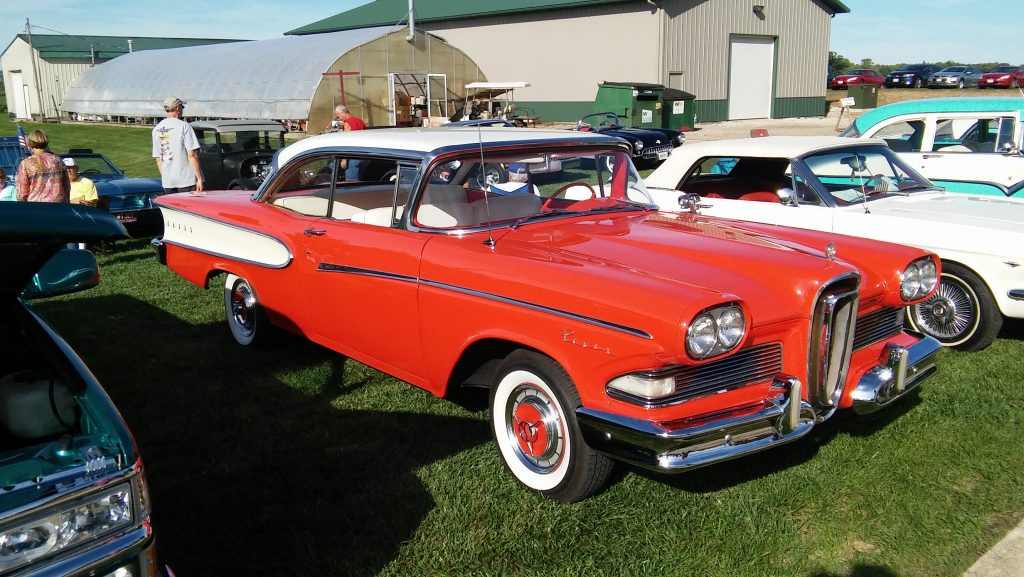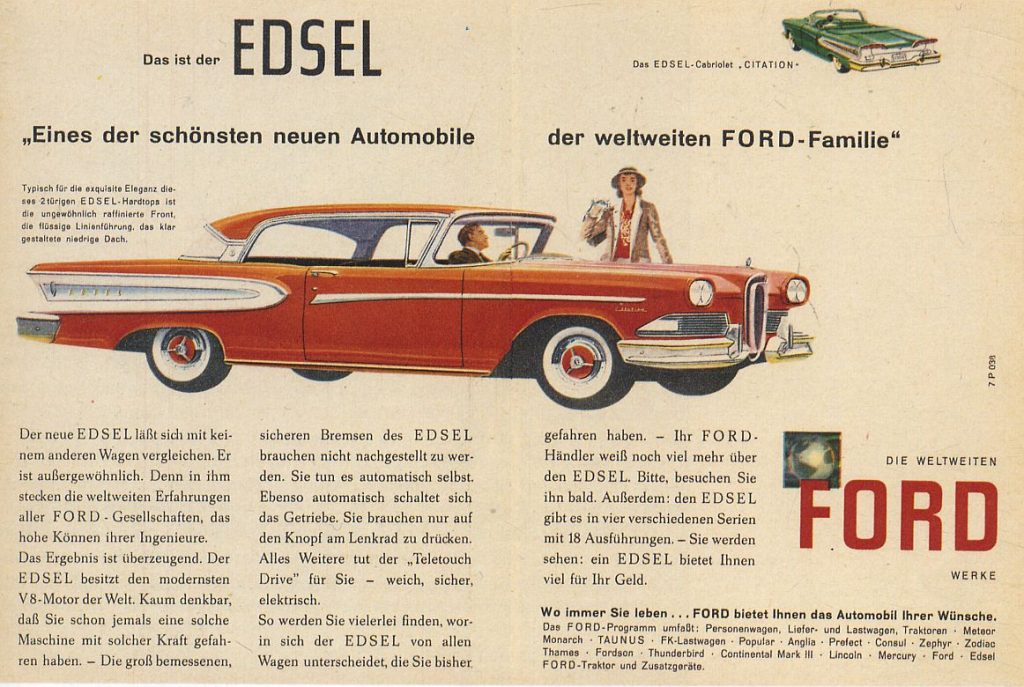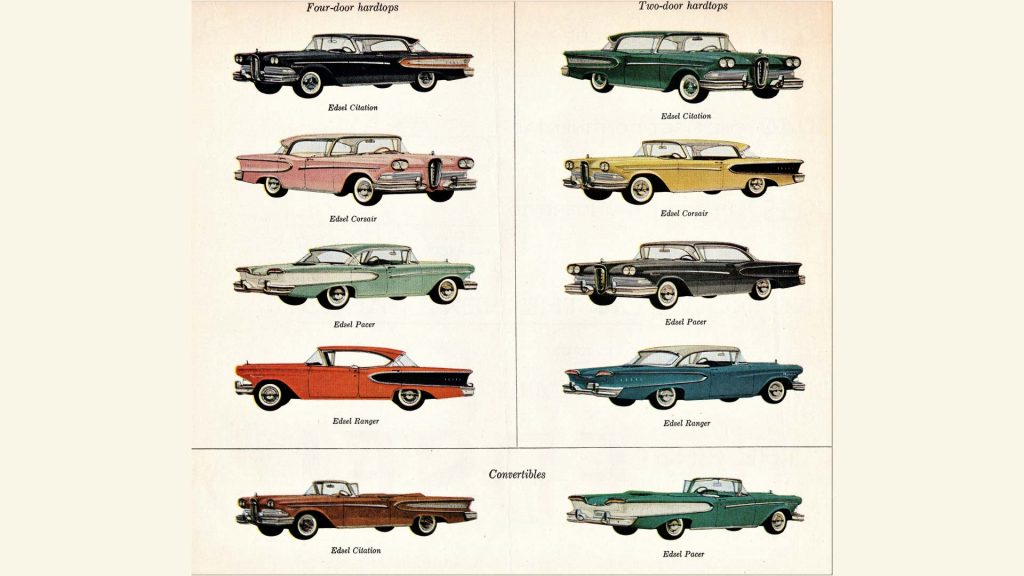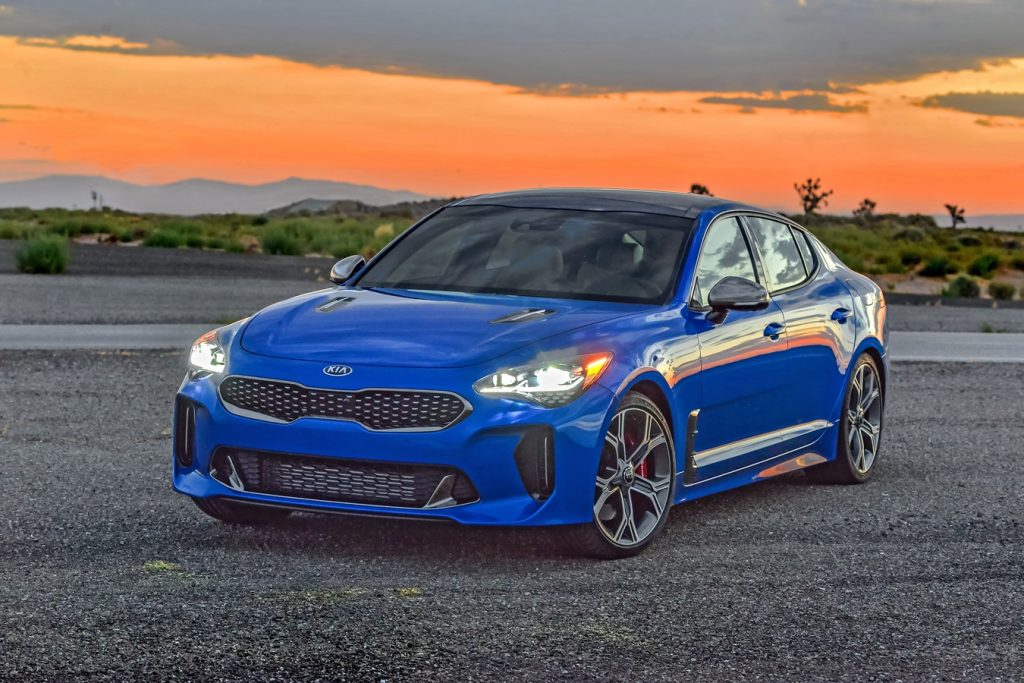
Marketing and Advertising spend is a factor of life for nearly all businesses. Even for small businesses making less than 5M per year in gross revenues, the SBA recommends spending 7-8% of revenue on marketing and advertising.
Many brands spend many millions of dollars on direct advertising and marketing, but also on product planning, focus groups on product research and “testing the waters” for what a new product should look like and how it’s core demographic will respond. Sometimes however this all goes wrong, and hundreds of millions of dollars are spent on a product that was built and designed using flawed data, poor product market fit test and the wrong assumptions.
This was the case for one of the US’s forgotten auto marque, Ford’s Edsel. During the 1950s-1980s different trim levels that would be present on a car now, were commonly separate brands under one umbrella. So for example now, you might buy a Ford Focus XL as the base model then various trim levels up to the full loaded Titanium or Platinum trim, but the car is still branded as a Ford Focus. Decades ago, many times Ford would use its own name on the base model, then the higher “trim levels” would be branded as separate models of sub brands, so for example Mercury or the top tier Lincoln. In some ways, in a limited manner this trend has continued under the General Motors umbrella with the Tahoe being the Chevrolet model, GMC’s Yukon being a slightly more upscale SUV that is nearly identical to the Tahoe, then the Cadillac Escalade being the top tier model of the same basic vehicle. Now however both Chevrolet, GMC and Cadillac offer various trim levels of their own models. Oddly enough you can buy a top tier Chevy Tahoe that is more expensive than a base level GMC Yukon. All these cars feature more or less the same architecture, transmission, suspension, electrical components and engine options ( slight horsepower differences exist between them mainly due to tuning). Visually the exteriors are different between them, and then the interior becomes increasingly nicer as you go from a Chevy to the Cadillac.
During the early 1950s Ford found itself wanting to build a new mid size sedan, which was all the rage at the time, much like today’s cross over small SUVs, that could compete with offerings from GM and Chrysler. Instead of just building a new model under the Ford badge, Ford wanted to launch a new brand, similar to how it had done with mercury and Lincoln, that would carry this new vehicle. Ford put together a massive marketing and engineering team to conduct seriously in depth consumer research to build exactly the car the target audience wanted.
This process took nearly two years with near constant advertising, committee design practices and market fit testing. The result was the Edsel and it was a massive failure. In fact it was one of if not the largest automotive product launch failure in history. ( looking at you Nikola to break this record in a few years).
But how could such an elaborate effort by such as huge company with a strong reputation screw up so badly? Let’s take a look.
The Market Changed
This is perhaps the most critical reason for failure of the Edsel. It simply took too long to bring this “perfect” car to market and in the two years of planning, the market changed. The economy was less vibrant and consumers were more interested in small/cheaper cars of which the edsel was not.
Ford had conducted a lot of testing, but kept the visual design of the car a secret, Ford only released teasers of the car without fully testing what others thought of the visual design. Many simply thought the car was ugly and by the time it was released, looked out dated. During the mid 1950s, mid size cars were selling impressive volumes, but by late 1957 or 1958, the market had changed, everyone other than Lincoln was struggling to move as many units as before of mid size vehicles. Brands such as Hudson, Packard, and Studebaker all were pulled from the market shortly after this period.
Cheaper cars such as the Ford Falcon, and American Motors Rambler were extremely popular, even the Volkswagen beetle was taking off in the US, with sales pushing over 50K annually.

Pricing
Getting a product or service priced right can be really tricky. Many brands struggle to get the ideal pricing right the first time and it can take some experimentation to get a price that is both profitable enough to be sustainable, yet still provides value to consumers.
In the case of the Edsel, it’s price was too close to that of Mercury, meaning it wasn’t segmented enough for consumers to understand where it really sat in the Ford umbrella. Without the brand loyalty, history and recognition that came with the other more established brands at the time, Edsel wasn’t really understood well. The Edsel was launched with 18 versions which also confused consumers.
Many consumers thought the name was odd and simply would rather spend their money on other competing products or on cheaper models. At the time, the Edsel sold for between $2,500 and $3,800. In comparison a 1958 Aston Martin DB4 cost around $7,500, with the average US salary of the time being $3,600. Of course now that DB4 would be worth in the 400-800K range.
Reliability
The Edsel was produced in a combination of Ford and mercury Factories with workers expected to constantly switch between building the Edsel and their standard production models. This created weird incentives in the factories to simply get the Edsels out the door as quickly as possible with little regard for how well it was put together.
Poor reviews and it’s reliability problems spread rapidly. This did not help the struggling sales as many of the cheaper Ford of GM models had better build quality and reliability than their more expensive counterpart.
Design by Committee Gone Wrong
Committee design can be both bad and good. At times, some of the best designs in the world are the creation of a singular vision followed through, but for mass market products, consumer research has to be taken into consideration. Even if Steve Jobs had the final say on what the new iphone looked like, he had a VERY good idea of what the consumer wanted backed by marketing research. Ford lacked a singular vision that was in step with their consumers. Instead generally relying on a cumbersome focus group approach that took too much time to convert into an actual design. Oddly enough, some of the worst flaws of the car were not focus group tested, and were the product of Ford execs overriding their design teams, including the name “edsel” and the exterior styling of the car. Both the look of the car and the name proved to be the wrong decision.
The launch of 18 versions of the car initially was also the result of committee design where no one took charge to combine many of the versions into 2-3 core models, Instead offering so many models that consumers were simply overwhelmed.

No plan B
Ford was 100% convinced this brand would launch to spectacular success and really had no backup plan if it didn’t. This was another major strategic error on Ford’s part as they weren’t quick enough to pivot the massive investment in the brand into a success of some kind. They were so confident of the new Edsel brand launch, they recruited over 1100 new dealers and their budget was near limitless.
What to learn from arguably one of the top ten ever worst product launches?
First, staying connected with a changing market is absolutely key to ongoing product launch success. Your vision should be backed up with data, but also have a focused vision on what your brand, product or service is and who are it’s buyers.
For tech startups, you have to minimize the length of time your design cycle takes. You could have a great idea or basis for a new app or SAS service, but if it takes you 3 years to make a demo, that market might have changed with new players entering and taking your targeted niche. Speed is everything for a startup!
Pricing as we said above can be challenging, but once product marketing fit is validated, a lot of attention should be paid to talking with potential customers and getting their feedback on pricing. Always make sure your pricing is at a level that your buyers feel they received value. It’s important as well to get potential customers to commit to buying or spending money on it as soon as possible. There are so many potential customers that will sign up for demos or act interested, but won’t actually spend money on the product or service. This is a very common issue with startups and is hard to fully remedy other than by getting customers to agree to actually spending money as early as possible in the process.
There have literally been books about it, but the lean startup approach to building new brands should be applied, especially for many small businesses and tech startups. Essentially the goal is to test your assumptions regarding who your target consumers are, what they want, and if you product fits their needs, all while spending as little money at each step to validate it. This way, you can conserve funds for the inevitable pivot or needed tweaking of your new product.

For automakers this is hard as developing new car models now take more money and time than ever due to the high demands of consumers, expected reliability, safety and electronics integration with the average new model taking 3-4 years to develop and costing several hundred million dollars. Car model launches still flop, but it’s been rare that they flop as hard as the Edsel. One such recent car sales struggle has been the Kia Stinger, a performance 40-50K priced, BMW m3 rival. Kia designed the car as a way to offer a more performance oriented mid sized sedan, yet by the time the car was launched, consumers were much preferring to buy sporty mid sized SUV cross overs. Unfortunately for Kia, the Kia brand doesn’t have the history or celebrated motorsport success to lure buyers away from their German rivals such as a Audi or BMW. Make no mistake though the Kia stinger is an excellent car, just not a great selling one. We should know…. We’ve filmed with one at a NASCAR raceway!
Recommended for further reading:
https://en.wikipedia.org/wiki/Edsel
https://time.com/3586398/ford-edsel-history/
Volan Media is a video production, augmented and virtual reality, web design and advertising agency for small and large businesses. We’ve worked with companies across the country ranging from tech startups to large automotive franchise groups. Check us HERE.



